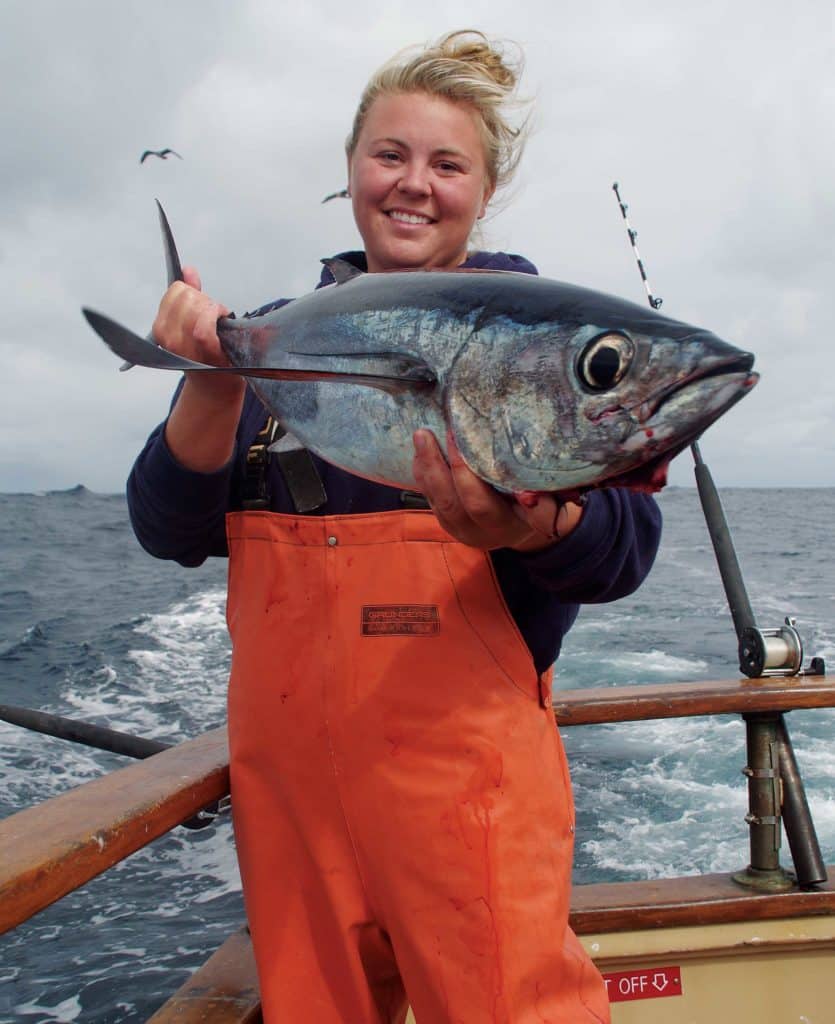
A chrome-blue torpedo of a tuna blows out from under the hull of the 55-foot Rampage, snatches the struggling anchovy, and dissolves into the depths. Monofilament peels off the reel with just enough drag to check backlash and streams into the blue.
I hang on and try to count slowly to 10. It’s almost impossible for a king salmon fanatic to wait for the recommended tuna 10-count while watching line fly off the reel. Count it down, engage the drag, and hang on. No need to set the hook, just hold on tight, raise the rod tip, and the albacore does the rest. But we’re learning, and judging by the upshot of albacore’s popularity in Oregon and Washington, Northwest anglers are loving what we’re learning.
It gets crazy when the tuna bite blows up and the boat parks in a massive school of torpedo-shaped eating machines that have evolved to swim continuously at bewildering speeds. As fresh anchovies hit the water, the tuna erupt, rods slam down, anglers collide, gaffs yank fish aboard, and the deck runs red. When skipper Randy Ratliff slips “Bad Moon Rising” into the sound system and cranks it up, it’s crazy on the back deck—almost as crazy as catching hot-blooded subtropical predators in cold North Pacific salmon waters.
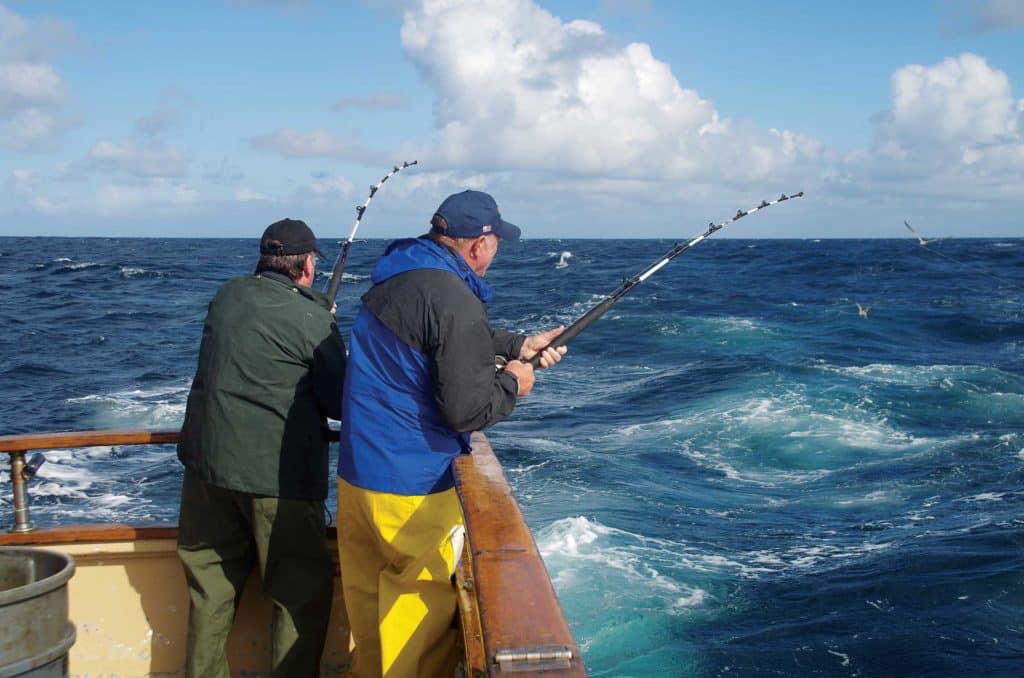
The swath of the 60- to 65-degree California Current knifes through 50- to 55-degree Pacific waters off the coasts of Oregon, Washington and British Columbia from mid-July until the storms of October, carrying schools of these pelagic predators with their 80-degree body temperatures on an annual invasion into iconic salmon waters.
Every trip is first a hunt for the meandering California Current. You know when you get there, and then it’s time to locate the migrating tuna.
The edge of the current is marked by a sharp color change; the cold dark green of the North Pacific changes to a warmer aqua blue. You’re likely to spot dolphins, turtles, sunfish, mackerel, and other fish rarely seen north of California, such as opah, dorado, marlin, and various jacks and tunas—mostly albacore and some bluefins. Included are huge schools of saury, the top forage for albacore, along with anchovies. Even the air has a different smell.
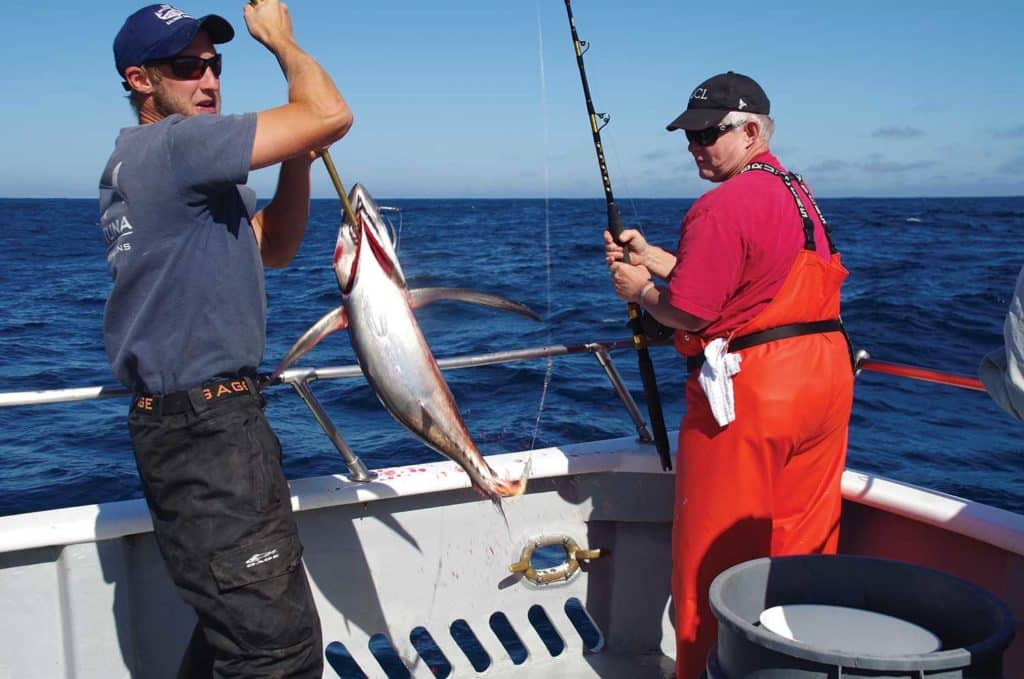
Albacore swim some 50 miles a day, and boats move fast, looking for specific water temperatures, watching for leapers, and zeroing in on commercial tuna boats.
We started this hunt the evening before, crossing the bar out of Westport, Washington, on a southeast course, looking for the California Current and the 62.5-degree water that Ratliff calls “perfect for albacore.” We found it in the dark, 32 miles out, slept until pre-dawn, then strung stout 6½-foot, 15- to 40-pound trolling rods, and pulled cedar plugs, skirted hex heads and plastic squid in the wake at 5 to 7 mph.
Tuna can be on the surface or as deep as 1,200 feet, depending on bait and water temperatures. A tuna 70 feet deep will come up for a skittering cedar plug, Ratliff says, and stay to gorge on chum.
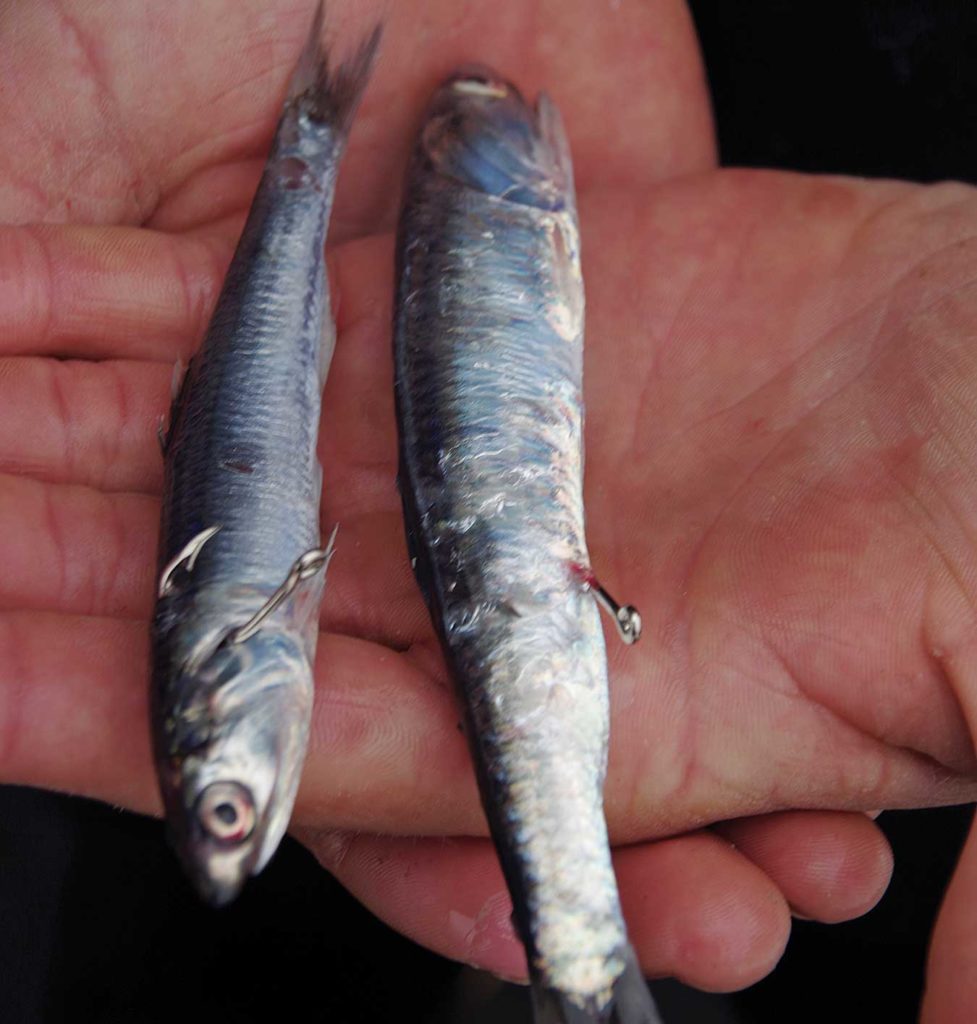
We troll until we locate the roaming schools, throw anchovies to hold them at the boat, and then fish live, unweighted anchovies. Lively baits are a must. Dead baits get sharked, and there are plenty of sharks—blues, makos, threshers, and even great whites.
“Don’t lose that fish,” Ratliff barks. “If it gets off and goes down, it’ll take the school with it.” He kicks Rampage into neutral and broaches to a wallowing stop. Anchovies go overboard by the handful to hold the school under the boat. Short-shank No. 2 bait hooks are pushed into live anchovies and free-spooled on the windward side. Baits panic and pull line off the spool. If your bait doesn’t pull out line, shake off the anchovy and get a fresh one.
The first baited rods pound down, and instructions boom off the bridge. “Stay over your fish. If it runs to the side, run with it. Follow it. If it gets out too far, it’ll tangle other lines and fight forever, or it’ll dive under and cut you off on the prop. Stay over it, and it’ll go into those tight tuna turns that will wear it out. Just clamp down and keep it under you. Reel, reel!”
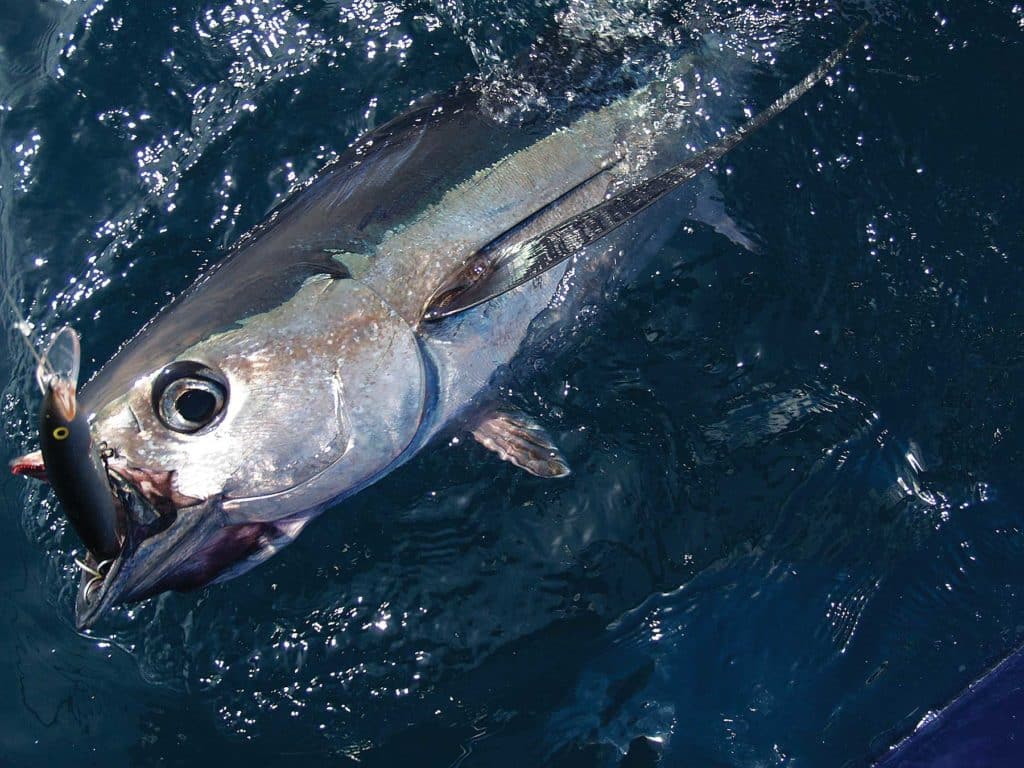
Down in the soft-blue water, on its side with pectoral fins locked in a powerful glide and moving in a tight spiral, my albacore very much resembles a dragonfly. That’s what Japanese fishermen sometimes call them, dragonflies, and I can see why. Their pectorals are half as long as the body, and look more like glider wings than fins.
Ratliff’s two-day trips have averaged around 18 albacore per person. The state average in Washington is more than eight per angler per trip, and with four fillets (two loins and two belly strips) per fish, most anglers are happy with half that. Three of the two-day trips I’ve been on, we’ve stopped fishing after one day because the boat’s 28-degree hold was full of iced albacore. Last year, success rose and plummeted on the whims of changing water temperatures and unseasonable storms. Whether great or so-so, we always come back with tuna, enough for our table, the extended family and good neighbors.
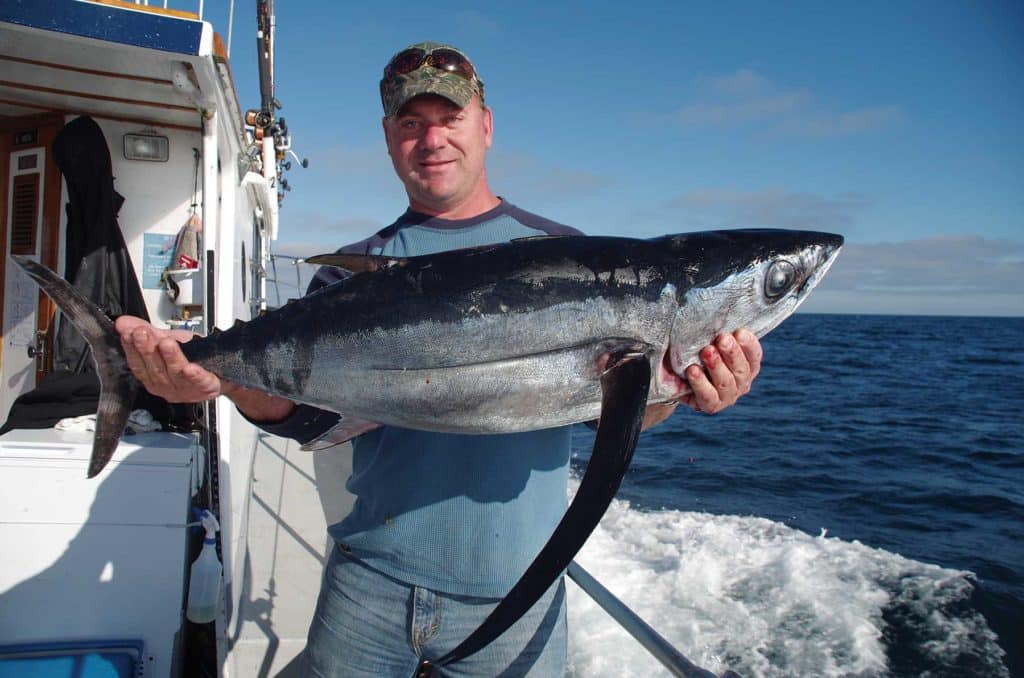
In a typical summer, twice as many albacore are caught off Washington than off Oregon or BC. The most productive albacore port—with the largest charter and private boat fleets in the Northwest—is Westport, Washington. There is also plenty of tuna action off Ilwaco and Neah Bay in Washington, and along the Oregon coast, off Newport, Charleston, Garibaldi, Depoe Bay, Bandon and Port Orford. In BC, late-summer anglers run primarily from Tofino, Ucluelet and Winter Harbor.
Read Next: Albacore Tuna Fishing in the Pacific Northwest
Albacore may never replace iconic salmon in the hearts of Northwest fishermen, but they are filling memory banks and freezers on a 900-mile front from Northern Vancouver Island in British Columbia, through Washington and Oregon, and down to Brookings on the California border.
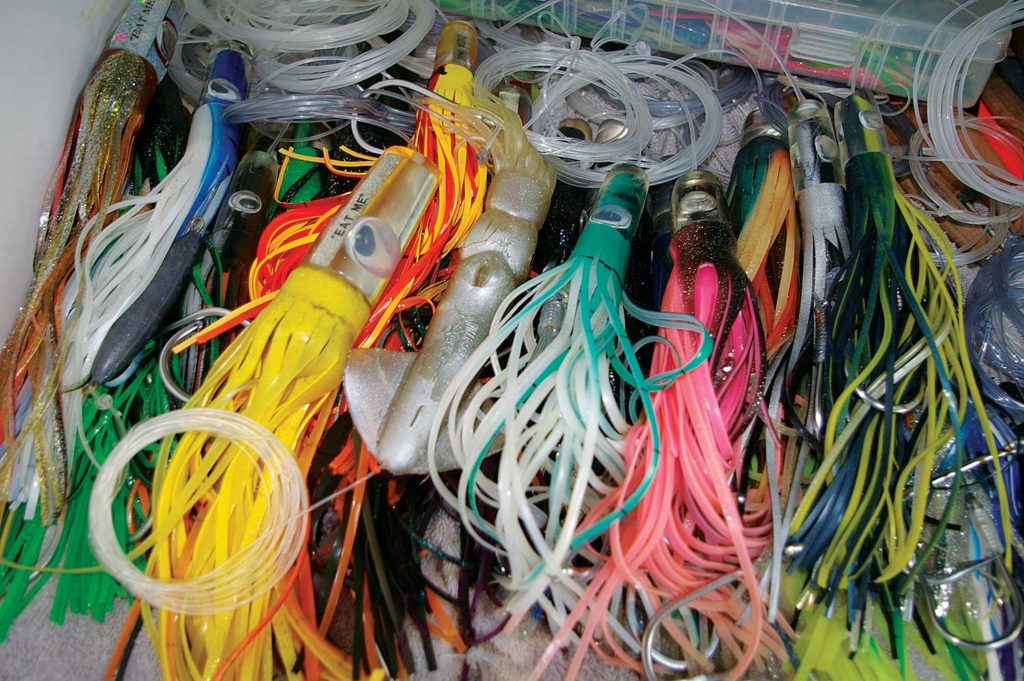
SWS Planner
What: Albacore. The average weight of a summer albacore ranges from the high teens to 35 pounds, but Washington’s state record is 52 pounds. Washington and British Columbia have no limit on albacore, although Washington does require a fishing license. Oregon allows a generous 25 fish per day, with no license required.
Where: California to British Columbia, more consistent from Oregon to the north.
When: July through October. The action starts in late June or early July off the southern Oregon coast, then moves northward, reaching Winter Harbor at the north end of Vancouver Island in August. Coastwide, August and September always offer the hottest albacore action, but October is when the biggest fish are caught.
Who: Boating anglers aboard seaworthy 22-foot or larger boats (multiple motors highly recommended) capable of 60- to 200-mile round-trip runs.
Washington
Westport
Westport Charterboat Association, charterwestport.com
Deep Sea Charters Inc., 360-268-9300 or 800-562-0151, deepseacharters.net
Ilwaco
Ilwaco Charter Association, visitlongbeachpeninsula.com
Pacific Salmon Charters, 800-831-2695, pacificsalmoncharters@hotmail.com
Coho Charters, 360-642-3333, coho@willapabay.org
Seabreeze Charters, 800-204-9125, washingtoncoastsportfishing.com
Oregon
Newport
Yaquina Bay Charters, 866-465-6801 or 541-265-6800, fishing@yaquinabaycharters.com
Newport Marina Store & Charters, 541-867-4470, nmscharters.com/map-contact
Garibaldi
Oregon Tuna Charters, 360-600-8257, oregontunacharters.com
Garabaldi Charters, garibaldicharters.com
D&D Charters, 503-322-0007, garibaldicharters.com
SWS Tackle Box
Rods: For live-baiting, 6- to 7-foot rated for 20- to 40-pound line; for trolling/jigging, 7- to 7 1⁄2-foot rated for 40-pound braid or mono
Reels: Penn FTH 30, Daiwa Sealine X40SHA or equivalent
Line: 20- to 40-pound pink monofilament
Lures: Cedar plugs, swimbaits, hex-head squid, 4-ounce jigs, 1 1⁄2-ounce leadheads









